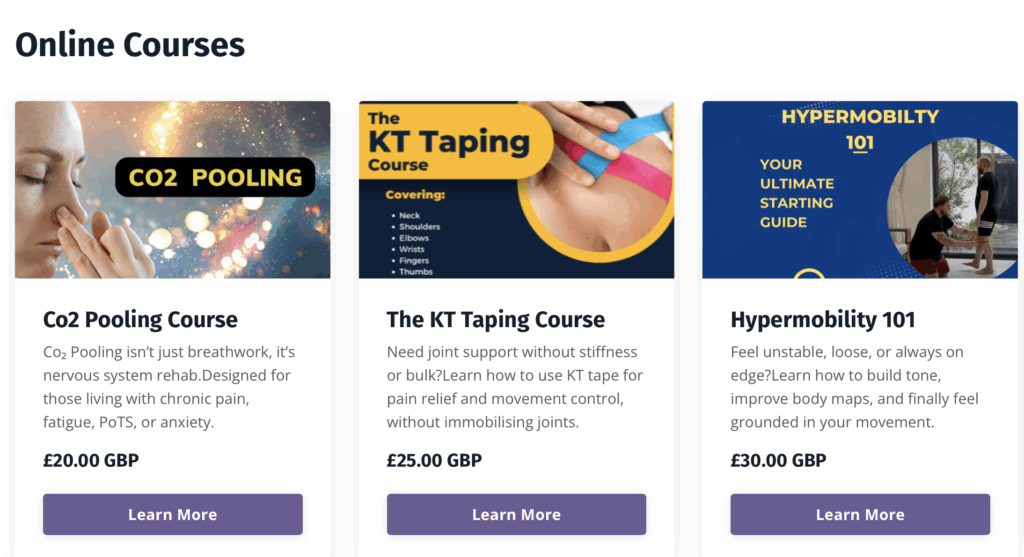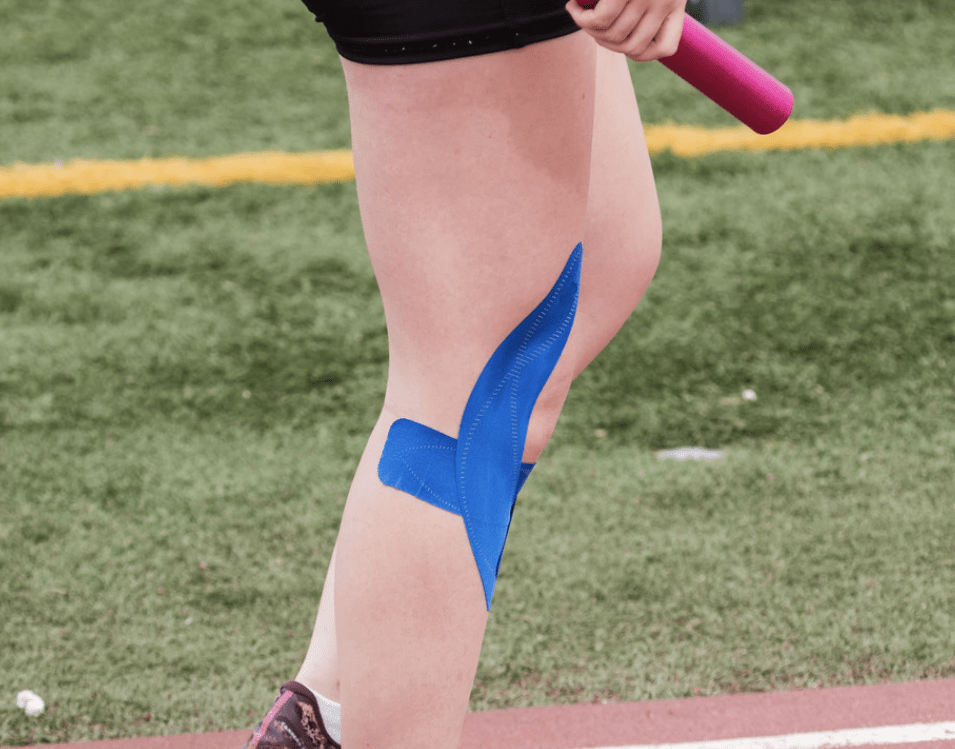- POTS and Exercise: The First Step Everyone Misses - 27 June 2025
- The Missing Link Between Breathlessness, Fatigue, and Chronic Pain: Understanding CO₂ Tolerance - 19 June 2025
- What is Mast Cell Activation Syndrome? - 12 May 2025
It is not uncommon to see those with hypermobility and EDS covered in an abundance of brightly coloured KT tape. Kinesio tape comes highly recommended for those with hypermobility, however, just like most modalities, there are those that find it helpful and those who do not. There is an abundance of claims when it comes to using KT tape, ranging from injury prevention to increased circulation. However, what does the research say about taping joints with KT tape when you are hypermobile?
This is the topic for today and boy is it a doozy!
This article covers:
ToggleA short history of KT tape
Kinesio taping was first brought about by chiropractor Kenzo Kase, back in the mid-1970’s, when he developed the original Kinesio Tape, which he called Kinesio Tex Classic. The term “Kinesio” is a shorthand for the word kinesiology, meaning “the study of movement”.
However, it’s important to note that this is not kinesiology, but rather good marketing. It could have easily been called a number of other things: Injury tape, Rehab tape, or Chiropractic tape. But that just doesn’t have the same ring to it, does it?
In 1980 Kenzo Kase established the “Kase Chiropractic Institute” in Kojimachi, Tokyo, and officially founded The Kinesio Taping Method.
By 1985 a dedicated taping instructor programme had been developed, and by 1989 the national Japanese volleyball team were using Kinesio Taping. Fast forward to 1997 and 7 of the major league baseball teams in America were using it.

At the 2012 Olympics, KT tape exploded! Many professional athletes were spotted on camera with colourful and elaborate designs, with even more elaborate reasons as to why they were wearing them.
At the Olympics there was a huge explosion in competition, with many new brands appearing also using the word ‘Kinesio’ in in the branding. Obviously, there are a few examples of cease and desist letters being sent in this time period, as Kase protected his trademark.
Benefits of KT tape for those with Hypermobility and EDS
There are numerous claims when it comes to taping joints for those with hypermobility, and the list will probably surprise you;
- Lifts the skin, decompressing the layers of fascia, allowing for greater movement of lymphatic fluid which transports white blood cells throughout the body and removes waste products, cellular debris, and bacteria.
- Promotes the body’s natural healing processes
- Rehabilitation for oedema and swelling management
- Improvement of performance, rehabilitation of neurologic dysfunction, management of scars and postural training
- Relieve pain while supporting muscles, tendons, and ligaments
- Provides 24-hour pain relief
- Recovery, performance, injury prevention
- Support and alleviate skin tension
- Support and stabilise muscles
- Reduce inflammation and support muscles
However, bold claims require extraordinary evidence. Once you cut through all of the marketing and fancy claims, there are only really three points that may have any substance to them: pain relief, injury prevention, and increased performance.
These extreme claims have resulted in class action lawsuits and caused companies who market Kinesiology Tape to have to remarket and change their claims, as well as pay out considerable sums of money.
Under the terms of the KT Tape settlement, KT Health Holdings Inc paid $1.75 million to resolve the deceptive marketing allegations. In addition to creating the settlement fund to reimburse customers, KT also agreed to change the way that tape is advertised, removing the label claims: “it will keep you pain-free,” “prevents injury” and “provides 24-hour pain relief per application.”
The kinesiology tape packaging also changed to include a large bold disclaimer, to inform consumers that the athletic tape is “not clinically proven for all injuries.”

Likewise, RockTape faced similar class action allegations that its tape doesn’t provide the advertised pain relief. Unfortunately, sports medicine is far from evidence-based, with inventions such as theracanes and scraping tools having a tiny amount of research. However, taping has over 2000! So research isn’t exactly lacking in this area. But what does it say?
The evidence for using KT when hypermobile
With so many claims out there for tape, it can be hard to separate fact from fiction, and placebo from actual mechanisms. As I mentioned before, once we take away the bogus claims, it leaves us with only three main points that may have any truth to them. If you are Hypermobile or have EDS, then I am going to assume that it’s more of the potential benefits to pain that you are most interested in.
The main issue with the current evidence on tape and hypermobility is that many of the research studies conducted conclude that KT tape may be effective, however, the quality of evidence (also known as grade) is insanely low. One example of this is a study in 2013(1) that concludes KT tape “may be effective in reducing pain during stair climbing activities”. However, the median effect of 0.5 on a pain scale from 0 – 10, was lower than the threshold of clinical importance. Meaning, that the quality of evidence for this study was rated “very low quality” as it was a single trial with a very high risk of bias. Some authors even concluded that Kinesio Taping was effective when their data did not identify significant benefits!
There is an abundance of people with hypermobility that rely on KT tape every day, yet in the same breath, there are people that it simply does nothing for. Likewise, if you take a closer look, there are also people who get negative effects from using tape, usually in the form of blisters, sensitivity, or burning, from the adhesive commonly used in Kinesiology Tape.
Whilst there is an abundance of research into KT tape, the research conducted around taping hypermobile individuals, who are arguably the population that needs it the most, is rather disappointing. Whilst some studies do show that KT tape may have some benefits when it comes to pain and hypermobility, most of the studies are fairly poor, lacking in control groups, consisting of very small sample sizes, and with no to very little follow-up.
A study conducted in 2021(2), showed that Kinesiology taping may be effective for reducing shoulder pain and improving function in patients with EDS up to 48 hours post application. But, again, this was a sample size of eight females, no control group, and a possible time effect. Hopefully, as research grows, a larger study will be conducted with a control group, more participants, and over a larger time period.
Likewise, a far superior study conducted recently in 2021 (3), showed that 10 sessions of shoulder rehab, over a 6-week time frame, found no difference when KT tape was used. Both groups improved over time, in hypermobility symptoms, range of motion, and functionality of the shoulder.
An interesting study showed that KT tape, when combined with foot strengthening exercises, compared to just strength exercises, was more effective at increasing navicular height: creating more of an arch. It was a decent sample size and could have been better controlled, but the main issue I have with this study is that it seems a little biased, directly quoting Kenzo Kase’s tape claims. However, it does give us a little food for thought. One of the exclusion criteria for this study though was no neuromuscular disorders, or more pertinent to hypermobility, no lower limb injuries.
The likelihood of someone using KT tape if they are hypermobile is because of recurring injuries and dislocations. So, how does this study compare to those who are injured and prone to dislocations? There is also the issue that one modality coupled with another, is pretty much always more effective than using a single modality alone.
An interesting study performed on recreational dancers found that Kinesio taping was fairly effective in eliminating sacroiliac joint pain, occurring in 13-25% of patients in the dance population (4). It’s a good idea to keep in mind, that people generally gravitate to activities at which they are naturally good at. This is one of the reasons why we find a higher prevalence of hypermobility amongst dancers, compared to say Rugby or other contact sports (5).
With research severely lacking in KT tape and hypermobility, I looked more towards the studies that would naturally include those with hypermobility, which is why these studies into dancers give us a little more insight into KT tape and hypermobility. Having analysed numerous publications on the effectiveness of Kinesio taping amongst dancers and athletes, you could conclude that KT tapes proves to be ineffective when it comes to increasing muscle strength or improving proprioception of the joints. However, only if it is used by healthy individuals using moderate physical activity (6).
Studies of Kinesio taping under strenuous physical exercises, for healthy individuals, have demonstrated numerous positive effects of taping, such as improvement of articular proprioception and postural stability (both static and dynamic), relieving of muscle fatigue and enhancing their recovery, as well as a reduction in the severity of delayed-onset muscle soreness. Kinesio taping turned out to be exceptionally effective for patients with different acute and chronic injuries of the musculoskeletal system. It helped to restore impaired proprioception, stabilise joints, ease pain symptoms, and improve muscle strength. However, there still is one giant issue when it comes to tape and hypermobility; what is the actual mechanism that yields these results? It is incredibly hard to dive deep into this topic with so little specific research into hypermobility and tape.
Not only is this a hard topic to research, but when we factor in the poor quality evidence of the studies and potential bias, it’s easy to get a headache.
Research comes with many levels of evidence, and unfortunately, most of these studies aren’t great. However, I did find a study that sits firmly at the top of the hierarchy when it comes to evidence (7). In this beautifully done research, it concluded that KT tape, when used for a range of musculoskeletal conditions, has no benefit over sham taping/placebo and active comparison therapies. In essence, the benefit was too small to be clinically worthwhile, or the trials were of very low quality.
Regardless of the comparison used or the outcomes investigated, most research typically showed no significant difference in outcomes between groups, or a trivial effect in favour of Kinesio Taping (ie, small enough to not be considered clinically worthwhile). It seems that the growing use of Kinesio Taping is due to massive marketing campaigns (such as the ones used during the London 2012 Olympic Games) rather than high-quality, scientific evidence with clinically relevant outcomes.
Therefore, current evidence does not support the use of Kinesio Taping for musculoskeletal conditions.
It is also possible that performance could potentially be increased, say through a combination of minor benefits. Alone they are hard to identify, but collectively they may be relevant. So there you have it, the evidence for using KT tape is not very good!
Why should you use KT tape if you are hypermobile?
The evidence shows us that KT Tape likey doesn’t do what it says it does, and any effects are likely a placebo or brought about by any number of biological, psychological, or social variables. But, some people with hypermobility like taping. It makes them feel better, experience less pain, and it makes them feel like their joints are more stable. If there was ever a reason to use tape, it’s not because of the crazy marketing, but of how it makes you feel.
So for the people who do seem to get pain relief from taping, why is this?
KT Tape for hypermobile pain
Well, for those with Hypermobility, and especially those that sublux/dislocate, nociceptive pain can play a large part in their life, and this is where it gets interesting.
Nociception is where high threshold nerves that detect potentially dangerous stimuli, such as extremes in temperature, pressure, chemicals and stretch, inform your brain that something may be wrong. However, keep in mind that this is not a pain signal, because they do not exist. Let’s leave pain receptors in 1664 where they belong. However, for those with hypermobility and EDS, recurrent subluxations/dislocations, are going to cause a lot of nociception. In fact, this may even lead to nociplastic pain, wherein your nervous system changes how nociception works, making it more sensitive to keep you safe.
Let’s say you sublux your hypermobile ankle. Extreme stretching(more about hypermobility and stretching here) of the ligaments and tendons is likely to cause a nociceptive response. Your brain decided that because of the context of the situation and about 50 million other variables, producing pain to stop you from bearing weight on your ankle and damaging it further, is a very good call.
Your joint isn’t dislocated, however, it did go out and then straight back in…this is known as a subluxation (you probably already knew that if you’re hypermobile). Depending on the degree of subluxation/dislocation that occurs, nerves and blood vessels may be damaged, muscles and ligaments may tear or twinge, the joint may swell, compression of nerves may cause tingling, and inflammatory responses can be activated. Say hello to nociception!
Due to the subluxation, you have a local inflammatory response. Your nervous system is on high alert and it’s sending far more information to your brain than it normally does when it comes to your ankle. Your brain receives around 11 million bits of sensory information every second, so what is a little more if it keeps you safe.
Tape very likely acts as a competing input for those with hypermobility, helping to drown out nociception to some small degree. If you stub your toe on a coffee table, you’re likely going to produce nociceptive pain. The first thing you are going to do is to rub your toes sending competing information to your brain to drown it out. This is why the pain changes from that sudden, acute, and sharp pain, to a more manageable low-level throbbing pain. So, it’s not a far stretch to assume that it is likely the same mechanisms at work.
Likewise, we are human and as such we are incredibly tactile. We love to touch. In fact, it’s one of the very first things we learn as babies, as our mothers cuddle us and provide love. It’s also one of the very first associations we make as small children. We fall over, we scrape our knees, and mum makes it better with a kiss and cuddle. As humans, we often learn that when it comes to pain, sensory information helps. If you don’t believe me, then the next time you stub your toe, just don’t rub it and see how long you can stand. Touch and sensory information for humans is innate.
In the weird world of pain, there are many things that mediate and contribute to why someone experiences it. Likewise, there is also an abundance of factors that help to reduce it, and touch and sensory information is one of those things. Taping a joint does seem to give people have more ownership over it, becoming acutely more aware of joint positioning (well kind of), as well as being more conscious when it comes to moving the joint. After all, it is a lot harder to sublux a joint, if you are paying attention to it. Which coincidentally, is the main mechanism most hypermobility rehab, pilates, and yoga programmes use. The only issue here is that you can be absolutely fine whilst doing the exercise (because you are aware), however, once you finish and go about your day, pop, there goes your joint.

We have said it a million times here at The Fibro Guy, the way that other professionals go about hypermobility rehab is not right at the moment. Consciously being aware of your joints does not stabilise them outside of sessions, only slightly inside of sessions. If you take a look a some of our clients, you will see that in a very short time frame their joints become stable outside of sessions not just inside, and this is largely because we work neurologically, and don’t stress conscious awareness.
KT Tape doesn’t immobilise hypermobile joints
Probably one of the better reasons to choose KT tape if you are hypermobile or have Ehlers Danlos syndrome, over say a rock-hard support splint, is the effect that immobilising can have.
Immobilisation can lead to hypoxic and inflammatory conditions in the joint capsule, which can easily become an initiating factor for issues such as joint contractures, as well as sending constant nociceptive signals.
With a joint that is repeatedly dislocating, there is a fair chance that the person suffering is likely going to avoid using the joint, choosing to immobilise it. This, however, can lead to a vicious cycle of disuse and lack of nourishment to the joint. In immobilisation studies conducted over 32 weeks by binding the hind legs of rats:
- Immobilised cartilage had increased collagen content (scar tissue)
- Articular cartilage was thinner
- The severity of osteoarthritis increased as measured by Mankin scores
- The trabecular bone plate area (the spongy bone at the end of long bones, like the thigh and shin bones) at the front and back of the shin showed bone loss, but not in the middle.
- Chondral vascular ingrowth was seen in the subchondral bone. This means that blood supply was increased to the bone as the cartilage and outer bone was dying.
- The centre of the knee joint was being fortified, as we see in the fact that bone loss was not seen in the centre of the top of the tibia bone.
Replacement of cartilage by bone may have been mediated by chondral vascularisation, suggesting irreversible changes. These findings stress the importance of weight-bearing and joint motion to maintain cartilage structure.
Not surprisingly, it has been shown that the more a specific joint is exercised, the stronger the bone-ligament and bone-tendon complexes become. Exercise specifically helps strengthen the fibro-osseous junction, which is where the ligament/tendon and bone attach to each other, and which, incidentally, is the area where Prolotherapy (often recommended and praised by the hypermobile population) treatments are administered.
With KT tape providing some sensory tickling, as well as helping to support the joint, but not completely immobilise it, it does have the potential to be a lot healthier, given the above.
KT tape for proprioception
So, a big reason why a lot of those with hypermobility and EDS use Kinesio taping, is because they feel that it adds to proprioception. Now I will preface this next section by saying here at The Fibro Guy, we do use tape occasionally, however, only ever in session, and we never make KT tape out to be more than it is. Tape can be helpful for some of our clients with issues like Thoracic Outlet Syndrome, to help cue them into positions where they aren’t causing compression. With that being said, it’s only ever added for a tiny boost to positioning and awareness. To be honest, it’s more like an addition to awareness, than actually increasing proprioception.
Research around proprioception and the use of KT tape in the hypermobile population, is again, unsurprisingly sparse!
An interesting study performed on those with hemiplegia due to stroke, found a difference in values before and after the tape was applied in the case of left and right deviation whilst walking (8). Not a fantastic study, due to a lack of controls, too small of sample size, and the fact that physiological and psychological factors were not considered relating to the subjects.
Many ankle studies show KT tape has no real significance when it comes to proprioception (9). Likewise, studies around the lower back and proprioception (10), yield the same results. One study looking at the effects of Kinesio taping of the knee on proprioception, balance, and functional performance in patients with anterior cruciate ligament rupture (ACLr) found some interesting results, in that KT may have beneficial effects on proprioception, balance, and functional performance in people with ACLr, but it cannot completely compensate for the loss of proprioception. The application of KT during rehabilitation may be a good therapeutic option either before ACL reconstruction surgery or as a conservative treatment for ACLr. However, it’s not a great study when it comes to tape, for many of the reasons I’ve already stated in the above paragraphs.
Then we have another study by a team of Italian researchers found that Kinesio Tape may help improve ankle stability for athletes with chronic ankle instability (11).
So, looking at the research, it looks like sometimes it may help slightly, other times it makes no difference at all, and there are 100,000 other variables that are likely involved, but unaccounted for.
Research always has limitations, and a large one is that a lot of these studies were performed with vision removed from the experiments. Vision is an important part of moving, as it works in conjunction with our cortical maps, to help us over through space and time. People, especially those with hypermobility and EDS, don’t walk through life with their eyes shut using just proprioception, they include visual data. Likewise, small sample sizes, some bias, and a whole host of other things, we end up with more questions than we first started with.
Should you use KT Tape for hypermobility and EDS?
By looking at the research, we can see that something happens when we use KT tape. I mean it’s probably not the KT tape that’s responsible, but a whole host of other factors. But, the fact remains, that KT tape may make people more aware of their joints, but more importantly, it might help contribute to less pain, and that’s what it’s about isn’t it.
Tape isn’t particularly invasive, it’s not damaging (well sometimes, and I will get to that), and it makes some people feel better. Given all of that, if taping does help you, then you don’t really have anything to lose; just don’t go expecting miracles. I think that the use of tape in this context is fine. It’s a little like stretching, a lot of the reasons people do it got debunked years ago. But, if it feels good and it helps, go for it.
So, you have taken a look at the evidence, and you realise that there isn’t anything specifically magical about the tape. However, you do fancy a little bit more awareness of your joints and a little bit of sensory tickling. Well, then, that’s a pretty good reason to use tape. Let’s take a look in the next few sections on how to tape. But first, let’s start with some KT tape tips, that are going to save you a lot of headaches.
KT tape tips when you are Hypermobile
Irritation
For those with EDS and velvet skin, and indeed even those without, perhaps those with mast cell issues, the tape can be an irritant, and in some instances cause blisters and soreness. For KT tape to stick to your skin, it is covered with adhesive. When you apply KT tape, you are recommended to rub the tape to help activate the adhesive. Now, if you do have skin that is irritable (and to be honest, I recommended this for everyone), do a little patch test first. Cut a small square of tape off and apply it to an area for 48hrs, then see how you react. Likewise a really handy tip if you are super irritable to tape, is to use barrier film spray, the same spray used for stoma bags.
Shave
It’s all well and good having your tape on, but there will come a time that you need to remove it. Even the smallest of hairs are going to hurt when the tape comes off. So, make sure that you shave the area if it is dense with hair, and you can save yourself some trouble in the future.
Tape stretches
Often people end up cutting off more tape than they actually need. Remember, that tape stretches, which means that once you apply some tension to it, it will reach further. This is a handy little tip, especially considering how expensive some tapes can be!
Round off the tape
KT tape has a tendency for the ends to curl up, getting caught on clothing. So, if you are going to tape, round off the corners of your tape and it will last far longer.
Tear the tape
Trying to pull the backing tape off KT can be frustrating. Instead, if you tear the tape with your hands, you will tear the backing paper, making it easy to remove, whilst leaving the tape unaffected.
Use water
When it comes time to take the tape off, take it off in the shower or bath. You will find it is far easier!
Should you use KT Tape for hypermobility and EDS?
By looking at the research, we can see that something happens when we use KT tape. I mean, it’s most likely not the KT tape that’s responsible, but a whole host of other factors. But, the fact remains, that KT tape may give people more awareness of their joints, but more importantly, it might help contribute to less pain, and that’s what it’s about really isn’t it.
So, for those of you who are wanting to tape hypermobile joints, we have compiled a few videos of how to tape some of the most problematic hypermobile joints.
We hope you enjoyed reading, and more importantly, feel more informed about KT tape and hypermobility.
— The Fibro Guy Team —
How to tape hypermobile joints
Enjoyed Our Blog? Take Your Knowledge to the Next Level!
If our blog posts have helped you better understand your body, imagine what a structured, step-by-step course could do!
The KT Taping Course is your practical guide to harnessing the power of KT tape for improved joint stability, reduced pain, and greater confidence in movement.

References:
1) Campolo, M., Babu, J., Dmochowska, K., Scariah, S. and Varughese, J. (2013). A comparison of two taping techniques (kinesio and mcconnell) and their effect on anterior knee pain during functional activities. International Journal of Sports Physical Therapy, [online] 8(2), pp.105–110. Available at: https://pubmed.ncbi.nlm.nih.gov/23593548/.
2) Levine, D., Tudini, F., Healy, M., Dunlap, A., Merritt, M., Vaught, E. and Norman, K. (2021). The Short Term Effects of Kinesiology Taping on Shoulder Pain and Function in Patients with Ehlers-Danlos Syndrome. Archives of Physical Medicine and Rehabilitation, 102(10), pp.e26–e27. doi:https://doi.org/10.1016/j.apmr.2021.07.535.
3) De Oliveira, F.C.L., Pairot de Fontenay, B., Bouyer, L.J., Desmeules, F. and Roy, J.-S. (2020). Kinesiotaping for the Rehabilitation of Rotator Cuff–Related Shoulder Pain: A Randomized Clinical Trial. Sports Health: A Multidisciplinary Approach, 13(2), p.194173812094425. doi:https://doi.org/10.1177/1941738120944254.
4) Berezutsky, V. (2018). Possibilities of kinesio taping to prevent injuries of professional dancers. International Journal of Occupational Safety and Ergonomics, 25(4), pp.638–645. doi:https://doi.org/10.1080/10803548.2018.1433281.
5) Skwiot, M., Śliwiński, G., Milanese, S. and Śliwiński, Z. (2019). Hypermobility of joints in dancers. PLOS ONE, 14(2), p.e0212188. doi:https://doi.org/10.1371/journal.pone.0212188.
6) Yam, M.L., Yang, Z., Zee, B.C.-Y. and Chong, K.C. (2019). Effects of Kinesio tape on lower limb muscle strength, hop test, and vertical jump performances: a meta-analysis. BMC Musculoskeletal Disorders, 20(1). doi:https://doi.org/10.1186/s12891-019-2564-6.
7) Parreira, P. do C.S., Costa, L. da C.M., Hespanhol Junior, L.C., Lopes, A.D. and Costa, L.O.P. (2014). Current evidence does not support the use of Kinesio Taping in clinical practice: a systematic review. Journal of Physiotherapy, 60(1), pp.31–39. doi:https://doi.org/10.1016/j.jphys.2013.12.008.
8) Park, Y.-H. and Lee, J.-H. (2016). Effects of proprioceptive sense-based Kinesio taping on walking imbalance. Journal of Physical Therapy Science, 28(11), pp.3060–3062. doi:https://doi.org/10.1589/jpts.28.3060.
9) Halseth, T., McChesney, J.W., DeBeliso, M., Vaughn, R. and Lien, J. (2004). The Effects of KinesioTM Taping on Proprioception at the Ankle. Journal of Sports Science & Medicine, [online] 3(1), p.1. Available at: https://pmc.ncbi.nlm.nih.gov/articles/PMC3896108/.
10) Abbasi, S., Hadian Rasanani, M.-R., Ghotbi, N., Olyaei, G.R., Bozorgmehr, A. and Rasouli, O. (2020). Short-term effect of kinesiology taping on pain, functional disability and lumbar proprioception in individuals with nonspecific chronic low back pain: a double-blinded, randomized trial. Chiropractic & Manual Therapies, 28(1). doi:https://doi.org/10.1186/s12998-020-00349-y.
11) Biz, C., Nicoletti, P., Tomasin, M., Bragazzi, N.L., Di Rubbo, G. and Ruggieri, P. (2022). Is Kinesio Taping Effective for Sport Performance and Ankle Function of Athletes with Chronic Ankle Instability (CAI)? A Systematic Review and Meta-Analysis. Medicina, [online] 58(5), p.620. doi:https://doi.org/10.3390/medicina58050620.





